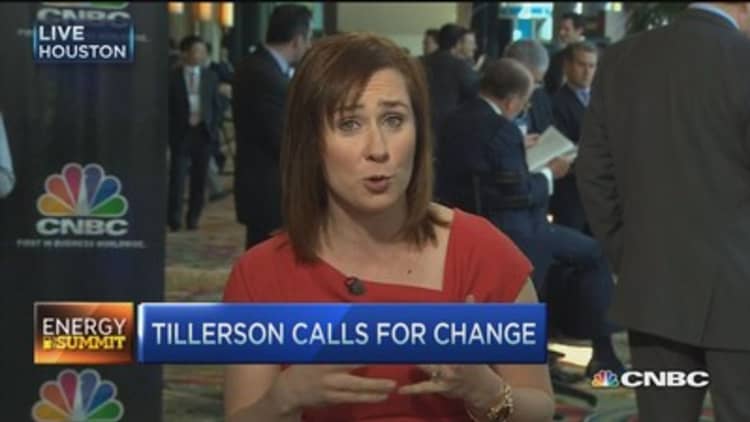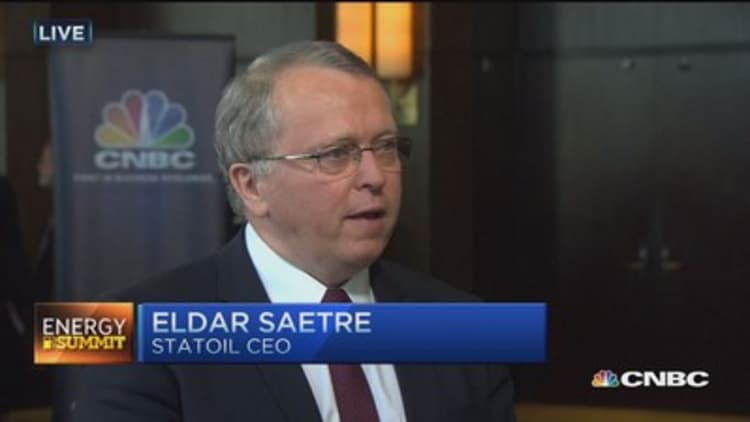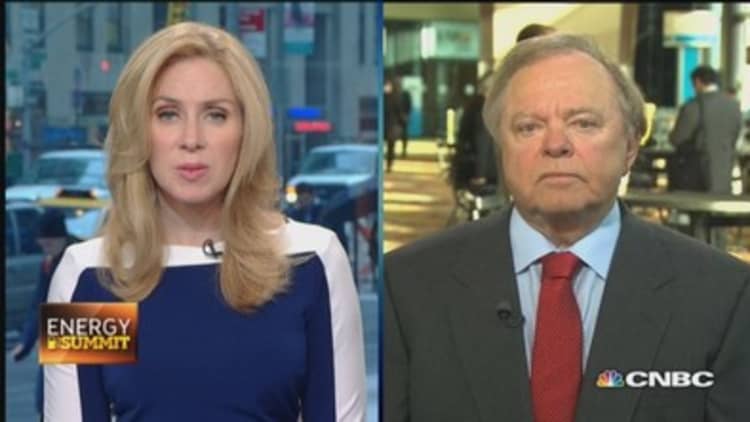



The global oil industry is bracing for a long period of lower prices.
"I think people need to settle in for us to be in a different price environment for at least a couple of years and then we'll see how things respond," said Rex Tillerson, ExxonMobil CEO. Tillerson was speaking at the annual IHS CERAWeek in Houston.
This is no ordinary period of decline. Executives at the energy conference described two factors that distinguish this price collapse from previous oil downturns, which has already brought a dramatic reduction in capital spending and other costs.
One is the fact that financing is still available to the industry, and the other is that it's still not clear how the upstart U.S. shale industry will deal with its first serious decline. So far, U.S. production has grown during the downturn, as the so-called "unconventional" industry continued to drill existing wells and focused on the most productive.
Scott Sheffield, CEO of Pioneer Natural Resources, said he's planning for five years of low oil prices, in the low $60s per barrel.
Other CEOs were expecting the same range for oil prices, though analysts say Wall Street has priced energy stocks on the prospect of oil closer to $75 per barrel.
Bob Dudley, BP group CEO, told CNBC on Tuesday, "I think it's lower for longer. Don't know how long ... several years absolutely a possibility. ... The rigs have come down from 1,600 operating rigs onshore in the U.S to 750 and yet oil production keeps going up."
Dudley added, "If there is a deal signed in Iran that will change the balance supply in the world. Chinese growth, certainly there, is coming down. So I do think the industry needs to prepare for lower for longer."
Read MoreThe world's most important oil producer is now ...
"We're planning for $60 oil," said Stephen Chazen, CEO of Occidental Petroleum. "I think there's still a lot of 'whistling in the graveyard' mentality.… One could hope for $75 oil but you've got to plan for lower."
Chazen said the fact that the capital markets are open to oil companies and that private equity is ready to invest is likely to prolong the low-price environment. In the past, banks were the lenders that stepped in during a crisis, but now banking reform has kept them sidelined and willing to redo existing terms but not willing to make new investments, he said.
The financing "has the ability to make the down cycle last longer. There's more capital. There's not as much pressure to do something," Chazen said.
Estimates of the amount of available private equity capital range from $80 billion to $100 billion. "It gives people firepower to put it back into shale," Sheffield said in an interview. "I'm a believer in $60 to $80 oil but because of this, it could be at the lower end of the range."
We had easy times. And we lost some control, I think, the way we spent the money. ... I don't blame anybody. It's human psychology.Patrick PouyanneCEO of Total
Industry executives say there are plenty of assets available for sale, and the industry expects to ultimately see a rash of mergers as the weakest players look for help and as others see bargain prices. But the wild card is how resilient shale will be in a low price environment, and how the industry will use technological advances to drill more efficiently.
"Understanding how the resource really behaves in a reduced environment of investment, we will all learn in this downturn," Tillerson said. Tillerson said the U.S. industry continued to deliver supply after OPEC's decision to let oil be priced by the market instead of its production levels and that OPEC was not really trying to threaten other suppliers. OPEC, he said, was in a "price discovery" process.
The U.S. oil industry is producing about 9.3 million barrels a day, a 40-year high and slightly lower than a recent peak of 9.4 million barrels a day.
In the year since the conference last met, oil prices have been cut in half, and West Texas Intermediate was trading Tuesday at about $55 per barrel, and Brent, the international bench mark trades about $7 higher.
Industry executives have been calling for exporting U.S. crude as a way to lift the domestic price closer to the international price, and to encourage more U.S. production.
Sheffield said if Congress were to allow exports, U.S. oil prices might move closer to $70 per barrel, in line with Brent. But he said gasoline would not increase since it is already priced on an international basis.
Becoming more productive
The industry has put aside some of its longer term, more expensive projects but companies are still looking for opportunity as rivals stand back.
"I think we have to take this challenging period, which could last, as an opportunity.... We had easy times. And we lost some control, I think, the way we spent the money, and we have to find bets on efficiency," said Patrick Pouyanne, CEO of Total. "I don't blame anybody. It's human psychology. So today we need to ... reset the cost base," Pouyanne said, adding, "You have to concentrate on lowering your breakeven, otherwise you have tough times."
Layoffs in the U.S. oil industry alone are estimated at about 100,000, and the industry has half as many active wells as it had in October. Oil service company Halliburton announced it was cutting 10 percent of its workforce on Tuesday.
Sheffield said he isn't laying off any workers but is reducing contractors and using attrition to trim headcount.
"Everybody is focused on high grading our areas where we drill," he said, explaining that he will now target operations at a well that could be more productive at a million barrels a day rather than 500,000 barrels a day.
Sheffield still expects U.S. oil production to grow, by about 400,000 to 500,000 barrels a day, half its recent pace.





